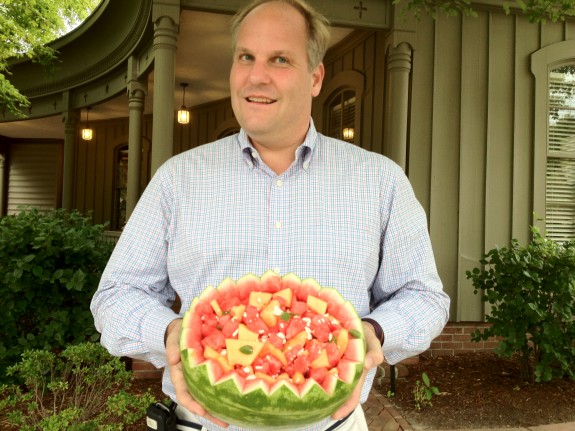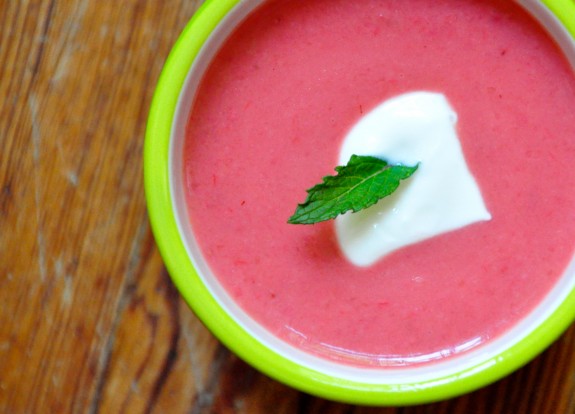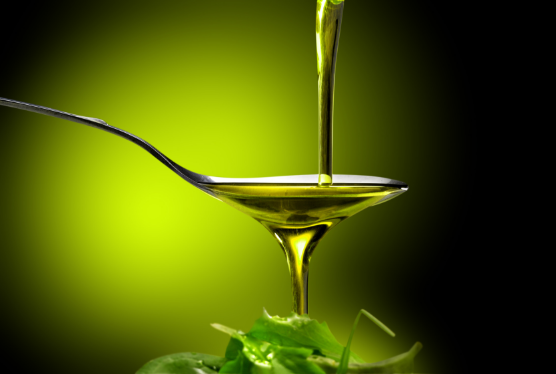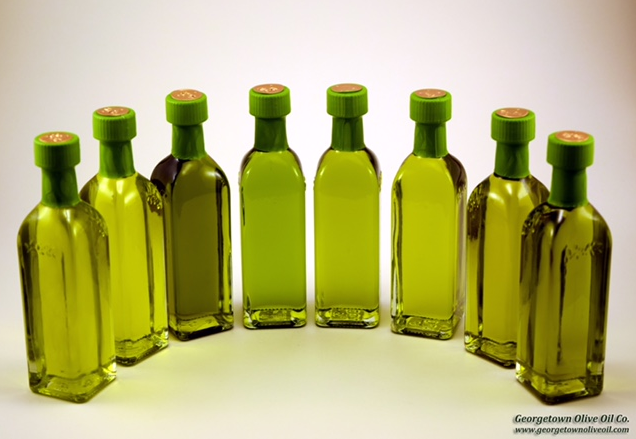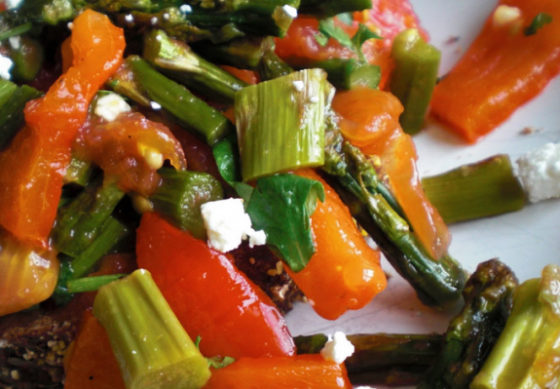Katherine’s Summertime Peach Crisp with Roasted Nuts, Dried Fruit & Ginger
- At August 10, 2017
- By Katherine
- In News, Recipes
 0
0
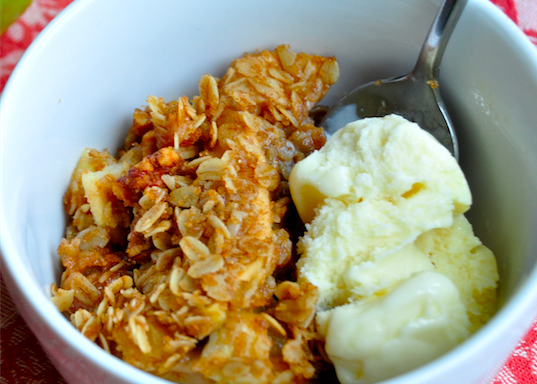
Katherine’s Summertime Peach Crisp with Roasted Nuts, Dried Fruit & Ginger (Photo by Alison Eaves, Washingtonian Magazine)
Katherine’s Summer Peach Crisp with Roasted Nuts, Dried Fruit & Ginger
By Katherine Tallmadge, M.A., R.D.
excerpted from “Diet Simple Farm to Table Recipes: 50 New Reasons to Cook in Season!” ($4.95)
Serves 12
Filling:
½ Cup Pure Maple Syrup
½ Cup Raisins, Dried Cranberries, or a mix of both
2 Tablespoons Fresh Squeezed Lemon Juice
1 teaspoon Minced Candied or Crystalized Ginger, to taste
2 Tablespoons All-Purpose Flour
3 pounds Seasonal, Ripe Peaches, peeled and thinly sliced
Topping:
1-1/2 Cups Old Fashioned Rolled Oats
½ Cup Chopped Walnuts, Pecans, Hazelnuts, any favorite Nut – or a mixture**
½ Cup Brown Sugar
1/3 Cup Whole Wheat Flour*
½ teaspoon Ground Cinnamon
1/3 Cup Walnut Oil, any Nut Oil,** or Canola Oil
Preheat oven to 350 degrees F.
Prepare filling: In a large bowl, mix the maple syrup, dried fruit, lemon juice, ginger, and flour. Add the peaches and mix well. Pour into a 9-by-13-inch baking dish.
Prepare Topping: Mix the oats, nuts, brown sugar, whole wheat flour, and cinnamon. Add the oil and mix until the topping is moist. Pour over the filling in the baking dish.
Bake for 45 to 50 minutes or until the apples are tender and the crumble is golden brown. Let stand for 10 minutes until serving
300 calories per serving.
“Katherine’s Summer Peach Crisp with Nuts, Dried Fruits, and Ginger” is adapted from a recipe in “Eating Well” Magazine.
*A whole grain – whole oats and whole wheat flour – has three parts: bran, germ and endosperm. The bran and germ contain fiber, Vitamin E, B vitamins (thiamin, niacin, riboflavin and pantothenic acid) minerals (calcium, magnesium, potassium, phosphorous, sodium, selenium and iron), protein, essential oils, antioxidants and phytochemicals (plant substances that may protect health). The endosperm contains mostly starch with a little protein and very few nutrients. When a grain is refined, turning whole wheat flour into white flour or brown rice into white rice, only the nutrient-poor endosperm is left. The heart-healthy, cancer-fighting riches found in the bran and germ are lost. Learn more about whole grains…
**Nuts – Every time a new study comes out about nuts – any nut – it’s positive news. Nut eaters around the world have fewer heart attacks, and we know that most of the protective nutrients are in the oil of the nut. While you already know each nut has a different look and flavor, each nut also has its own unique nutritional characteristics. For instance, almonds are the highest in protein and Vitamin E, and the lowest in artery-clogging saturated fat. Walnuts are the only nut with omega-3-fatty acids. Pecans have the highest antioxidant content. Pistachios contain lutein, a compound which may significantly improve eye health. ALL nuts are good for you. My favorite: Italian Hazelnuts!
Sweet Summertime Melon Chunks with Crumbled Feta and Fresh Mint
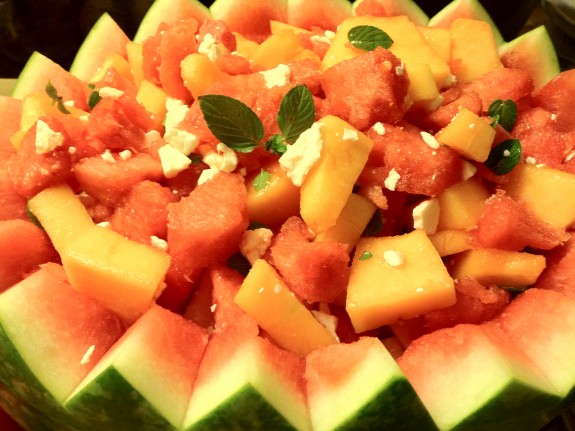
Sweet Summertime Melon Chunks with Crumbled Feta and Fresh Mint (from “Diet Simple Farm to Table Recipes”)
Excerpted from “Diet Simple Farm to Table Recipes: 50 New Reasons to Cook in Season!“
It’s melon season and a vast number of varieties are now available, and will be for quite a while. These days melons come in an amazing array of colors, shapes, textures, and flavors. Use a combination of any melons for this very simple, yet elegant recipe. This is an unusual combination of flavors and textures, and a delight on the palate. Use any kind of melon that happens to be in season.
Serves 8
2 pounds melon chunks (about 1 small cantaloupe or seedless watermelon)
½ pound Feta Cheese or other similar cheese
8 small mint leaves, Chiffonade (Basil will also work)
Combine ingredients in a large bowl and serve!
I’m In Tomato Heaven Recipe! Greek Salad with Heirloom Tomatoes
I’m in tomato heaven! Tomatoes are my favorite vegetable (maybe because they’re actually a fruit!). It all started with my Grandmother. She would plant dozens – or it seemed like dozens to a child – of tomato plants every year in her huge vegetable garden. We’d pick them ripe from the vine, and eat them while still warm from the summer sun. I’ll never forget how soft, juicy, and red throughout they were. I feel so lucky that today, we have our Farmers Markets growing these kinds of spectacular specimens… of all shapes, sizes, colors, textures, and flavors!
Heirloom tomatoes are old varieties of tomatoes which have been passed down through generations. They are tastier, but more delicate, because they’re bred to be picked and eaten right away – they’re not bred to travel (as many of the tomatoes in the grocery store may be). Heirloom varieties have natural resistance to pests, disease and are better able to tolerate local conditions without too much extra energy, pesticides or water. Locally, organically produced food saves water, energy and encourages a region’s unique varieties of fruits and vegetables.
Greek Salad with Heirloom Tomatoes
excerpted from “Diet Simple Farm to Table Recipes: 50 New Reasons to Cook in Season!” by ME (only $4.95)
Serves 8
Ingredients:
Vinaigrette:
2 Tablespoons Freshly Harvested Extra Virgin Olive Oil
2 Tablespoons Freshly Squeezed Lemon Juice (1 Lemon)
1 Tablespoon Chopped Fresh Oregano or Basil (or 1 tsp dried)
1 Clove Garlic, Minced (optional)
Salt and Pepper to Taste (Salt is not necessary with the cheese and olives)
Vegetables:
2 cucumbers, peeled, seeded and sliced into a half-moon shape
1 onion, peeled and chopped coarsely
1 medium yellow, purple or green bell pepper, cored, seeded, chopped into large bite-size pieces
1 cup pitted Kalamata or other Greek Olives
4 Heirloom Tomatoes, quartered, and cut into large, bite-size pieces (or any vine-ripe tomatoes)
4 ounces Feta or Goat Cheese, broken into small bits
Instructions:
Combine the vinaigrette ingredients in a large salad bowl and whisk until blended. Add the cucumbers, onion, pepper, and olives and toss into vinaigrette. Let sit for twenty minutes to marinate. Add the heirloom tomatoes and cheese when ready to serve.
Tomatoes are one of the “superfoods.” Men who consumed 10 or more servings of tomato products a week had a 35% decrease in risk of prostate cancer relative to those who consumed 1.5 servings or fewer per week. This is largely attributed to “lycopene” in the tomatoes, which is also in other red fruits such as watermelon, pink grapefruit and guava. Men with lycopene levels in the top 20% had a 46% decrease in risk of heart attack compared to those in the bottom 20%. Lycopene is a potent scavenger of gene-damaging free radicals. But don’t expect to get it from a supplement. You must eat the tomato as you need the whole food to receive the benefits! But because lycopene is fat-soluble, you must eat the tomato with an oil of some kind for it to be available to your body.
Lycopene (Red fruits such as tomatoes, watermelon, guava): Many studies have shown that lycopene-rich foods reduce the risk of prostate cancer, but the mechanism behind that reduction was not well understood until now. A recent study found that lycopene has a substantial protective effect against prostate cancer by interfering with the genes that would allow the prostate cancer cells to grow and survive. The American Institute for Cancer Research recommends that men take advantage of lycopene’s cancer-preventing effects and fill their diets with foods such as tomatoes, watermelon and guava.
Summer Peach and Fresh Kale Salad with Toasted Almonds and a Balsamic Vinaigrette
- At July 19, 2017
- By Katherine
- In News, Recipes
 0
0
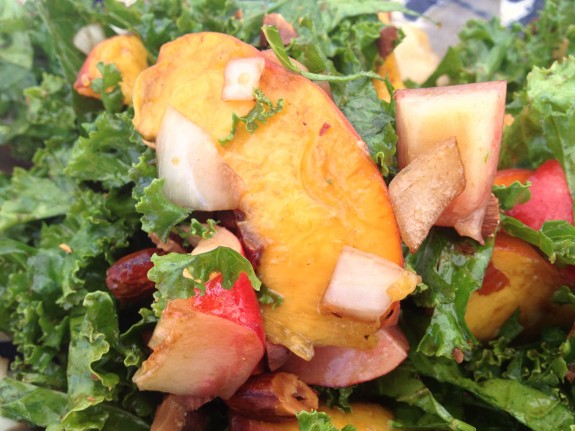
One reason I look forward to peach season is being able to make this recipe. This year, the peaches are abundant, sweet, juicy, and dense. Take advantage and find ways to include them in your recipes and meals, even if it’s just biting into a whole one and letting the juice roll down your arms. This salad is always a hit, perhaps because we’re naturally drawn to its variety of flavors, textures, colors, and shapes. Variety is the most significant reason we choose something to eat!
Salad With Summer Peaches, Fresh Kale, Toasted Almonds and a Balsamic Vinaigrette
Read More»Katherine’s Crepe-Style Swedish Waffles with Succulent Strawberries

Late spring and early summer strawberries are especially sweet and succulent, especially if they are grown locally and picked at peak ripeness. I experienced a very decadent way of enjoying them while relaxing during a recent respite in the Pennsylvania countryside, with my friend, Anna: Smothering heart-shaped Swedish waffles. These aren’t ordinary waffles; they’re crepe-thin, crispy, buttery, and simply divine. Traditionally served on “Waffle Day,” in Sweden, celebrating “Our Lady’s Day,” on March 25th, 9 months before Christmas (also known as the Christian holiday of “Annunciation”). Enjoy…
Katherine & Anna’s Luxurious Swedish Waffles with Strawberries
Serves… You decide the number!
3 eggs
1 dl (3.4 ounces) Flour
6 dl (2.4 cups) Whole Milk (or 1% Milk)
1/4 cup melted, cooled Butter (or Canola Oil or Walnut Oil for a nutty flavor)
Pinch of Salt, Sugar, or Vanilla (optional)
Topping:
1/2 cup (or more) Plain Yogurt, Whipped Cream or Ice Cream
1 cup (or more) Strawberries, other fruit, or preserves like Swedish Lingonberries
1 teaspoon Maple Syrup or Confectioner’s Sugar (optional)
A sprinkling of chopped Roasted Nuts (optional)
1 sprig of fresh Mint (optional)
Whisk the ingredients together in a pitcher. Grease the waffle iron with butter or oil for the first waffle. Since butter (or oil) is in the recipe, the waffle iron will not need to be greased again.
Pour a small amount of the mixture into the Euro Cuisine Eco Friendly Heart Shaped Waffle Maker per product instructions. When golden brown, carefully lift the waffle and place in the center of your plate (smother in butter if you’re being especially care-free and decadent). Place the yogurt, ice cream or whipped cream, berries or other fruit, and roasted chopped nuts, if you wish, on the waffle. Drizzle maple syrup on top. Finish with a sprig of mint.
Lingonberry preserves are widely used in Sweden. They’re sweet and tart, and taste great with plain yogurt or sour cream. They make great toppings for crepes and Swedish waffles.
If you want more of a decadent cake-like dessert, thinly spread butter on the waffle, then sift confectioner’s sugar on top.
NOTE: Using butter, whole milk, ice cream and whipped cream make these delectable waffles occasional dessert treats, and I recommend using them sparingly. When Anna and I prepared them last weekend, we used 2% milk and butter in the recipe. I topped my waffle with Chobani nonfat plain yogurt with a little maple syrup drizzled on top. Anna used whipped cream!
Springtime Strawberry and Goat Cheese Salad
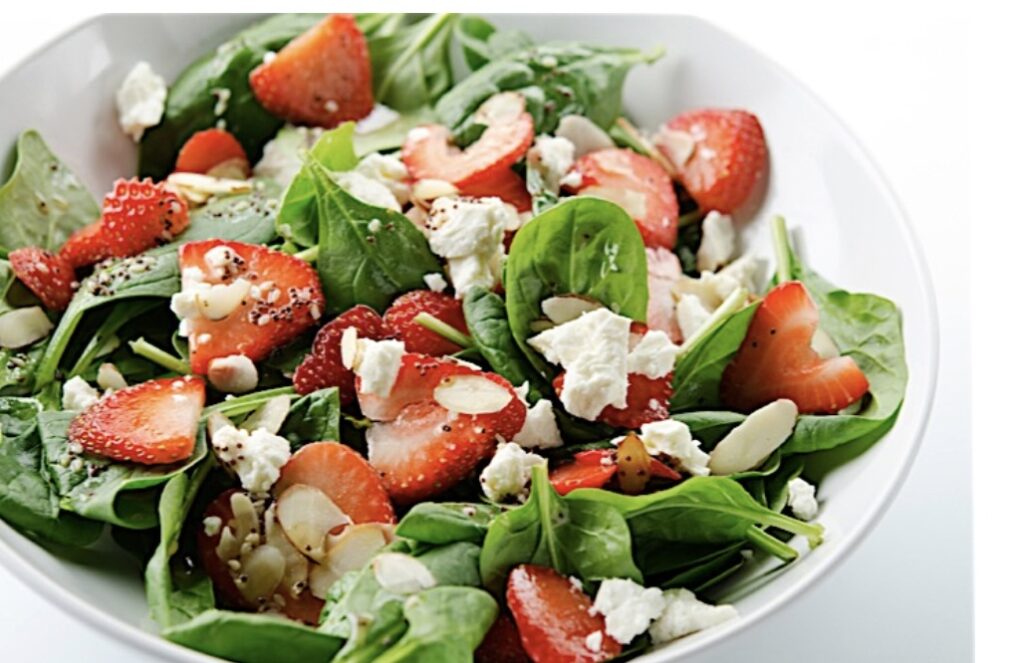
Four Tips for Choosing the RIGHT Olive Oil
My clients regularly ask me how important using olive oil is. Of course, we have all heard about olive oil’s health benefits. But there is still understandable confusion. I’m regularly asked, “How does olive oil compare to other oils? How does it work? What kind of olive oil is best? How much should I use?” My answer: It depends…
These are important questions as more and more science is finding that the nutrients in olive oil, called “polyphenols,” are responsible for its superior health benefits. Increased longevity, reductions in cardiovascular disease, metabolic syndrome, obesity, diabetes, and various cancers, are among the benefits, confirmed a 2015 review of studies published in the British Journal of Nutrition. But olive oils can vary significantly in their polyphenol content. There are four times more phenolic compounds in high quality extra virgin olive oil versus low quality or refined olive oil – 232 mg vs 62 mg per kilogram of oil – so it is important you choose the right olive oil.
“99 percent of olive oil’s health benefits are related to the presence of the phenolic compounds, not the oil itself,” said Nasir Malik, NIH Scientist. “And without the polyphenols, you might as well use the less expensive canola oil.”
Surprisingly, when tested by the U.S. Department of Agriculture, polyphenols were low in most commercially available olive oils. They also didn’t live up to international quality standards defining extra virgin olive oil. These standards require an acidic pH, necessary to protect the nutrients. And the olive oils’ pH had degraded – even in the highest end gourmet shops – according to studies conducted at the University of California at Davis Olive Center.
That’s because olive oil’s polyphenol content diminishes, and its acidic pH degrades over time, as days, weeks, and months go by after harvest. Other factors play a role, too: the harvesting methods, the age of the trees, the ripeness of the olives, the processing, and the storage. Since time, heat, and light affect polyphenol content, choose olive oil that:
- Is no more than one year old (look for the harvest date on the label),
- Is in an air-tight, dark glass, or tin container,
- Is stored in a cool environment, and
- Smells and tastes like olives, which could be fruity, grassy, or peppery.
Is olive oil better for your health than other oils? The answer is yes, according to a new study in Nutrition & Diabetes. For one, “The risk of type 2 diabetes reduced by 13% with increasing intake of olive oil up to 15 to 20 grams per day (3 to 4 teaspoons),” according to the study. When refined olive oil, or other oils, were compared, fresh extra virgin olive oil was more beneficial for the prevention and management of diabetes. It was associated with lower fasting blood glucose, and Hemoglobin A1C, a three-month average of blood glucose and an important marker for diabetic complications.
Other studies have found high polyphenol olive oil improves health in many ways:
- Increasing levels of good cholesterol (which helps clear artery-clogging fat from the bloodstream),
- Improving artery wall health and functioning (important for healthy blood pressure, blood flow, reducing blood clots, and the risk of cardiovascular disease), and
- Reducing oxidation and inflammation processes involved in many diseases from infections to cancer.
To take full advantage of your olive oil’s flavor and health benefits, save your recently harvested, high quality extra virgin olive oil for drizzling on vegetables, salads, or anything! When cooking with high heat, i.e., stir frying, use canola oil or nut oils instead, as they can be less expensive, and have higher smoking points so can tolerate higher temperatures without burning.
My favorite vinaigrette: Mix 1 or 2 tablespoons of olive oil with 1 or 2 tablespoons of freshly squeezed lemon juice, salt and pepper. The proportion of olive oil to lemon juice depends on how tart you like your vinaigrette. You can also add a smidge of mustard or herbs. Serve!
One shop in Georgetown which consistently sells high quality olive oils is Georgetown Olive Oil company. It is locally owned and operated at 1524 Wisconsin Avenue. The shop displays rare-to-find information, such as the oils’ date of harvest, provenance, and detailed descriptions. And you can taste any of the oils at any time. I highly recommend this cozy and friendly specialty shop where they clearly understand what makes a great olive oil!
For more detailed information on olive oil, read my Washington Post article: “Most Olive Oil is not as Healthful as You Think”
My Favorite Asparagus Recipes
Spring has always seemed more like the new year to me than January first. Perhaps my inspiration comes from longer, warmer, sunlit days, delicate vegetables and fruits, like asparagus and strawberries, finally popping up, flowers blooming everywhere. Neighbors begin venturing out of winter hibernation with their first happy greetings of the year, with sounds of their children playing in the street. Celebrations are occurring all over the city showing off our beauty and splendor to the tourists. In fact, I think I’ll make my New Year’s Resolution today! And it’ll be easy – preparing batches of veggie salads – or soups, at least weekly, to help me and my friends shed some of our winter “padding.” Making delicious veggies your main course at dinners (lunches, too) helps manage your weight easily. Asparagus is one of my major harbingers of spring. Here I’d like to share some of my favorite asparagus recipes excerpted from my book, Diet Simple Farm to Table Recipes: 50 New Reasons to Cook In Season!, where you’ll find dozens of other seasonal recipes:
Chilled Asparagus in a Creamy Tarragon, Shallot and Roasted Walnut Vinaigrette
Salad of New Potatoes and Asparagus with Lemony Garlic Herb Mayonnaise
Pasta with Pesto, Roasted Asparagus and Cherry Tomatoes
Asparagus Salad in a Vietnamese-Style Dressing
Fresh Kale and Summer Peach Salad with Toasted Almonds and Balsamic Vinaigrette
- At July 31, 2016
- By Katherine
- In News, Recipes
 1
1
 The local peaches at this year’s farmers’ markets are exceptional: sweet, juicy, flavorful. This recipe is a perfect way to feature them at any gathering. And it’s always a favorite! Excerpted from my book: Diet Simple Farm to Table Recipes: 50 New Reasons to Cook in Season!
The local peaches at this year’s farmers’ markets are exceptional: sweet, juicy, flavorful. This recipe is a perfect way to feature them at any gathering. And it’s always a favorite! Excerpted from my book: Diet Simple Farm to Table Recipes: 50 New Reasons to Cook in Season!
Serves 6
Vinaigrette:
3 Tablespoons Extra Virgin Olive Oil
1 Tablespoon Balsamic Vinegar
Salt and Pepper to taste
Salad Ingredients:
6 Handfuls of fresh Kale (or other greens), washed, tough stems removed, and torn into bite-sized pieces
2 Cups Fresh Sliced Summer Peaches and/or any seasonal Berries
2 Ounces toasted slivered Almonds
½ Sweet Onion, peeled and sliced
In a large bowl, add the olive oil, vinegar, salt and pepper. Whisk together. Add the kale, onion, almonds, and peaches and toss together. Serve immediately.

